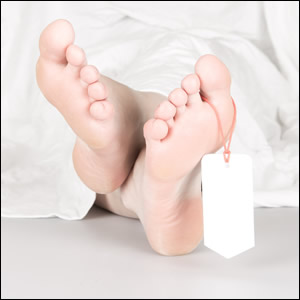Tech at Work: Virtual Autopsies
Using robots and imaging technology to make autopsies more efficient and less costly may seem like a no-brainer, yet when we look at the tech at work, virtual autopsies remain controversial around the world.
Who’s afraid of a dead body?
 Based on the success of television shows like CSI and Bones, it looks like not many in the viewing public. Of course, those decomposing, bloody corpses remain at a distance, behind the screens and “inside” our televisions.
Based on the success of television shows like CSI and Bones, it looks like not many in the viewing public. Of course, those decomposing, bloody corpses remain at a distance, behind the screens and “inside” our televisions.
But now, technology is using screens (and medical imaging technology) to make the autopsy process less messy and, some argue, more accurate. “Virtopsies,” or virtual autopsies, use imaging and robotic technology to scan bodies, often solving mysteries that would not be possible with conventional autopsy procedures.
“Virtual autopsies represent an exciting opportunity to further advance medical technology, and we are confident high-reliability connectors will be a key contributor to that pursuit,” says Roberta Rebora, vice president, marketing and communications, Smiths Connectors.
What It Is
The “virtopsy” is trademarked by Professor Richard Dirnhofer, former head of the Institute of Forensic Medicine at the University of Bern in Switzerland. In a paper published in 2010, Dirnhofer wrote that the process provides “a complete and true picture of the object provided” and later said that it allows the pathologist’s report to “photograph” with words “so that the reader is able to follow his thoughts visually.” Clearly, this could make all the difference to a prosecutor presenting complicated medical findings to a jury in a murder trial.
Michael Thali, current chair of the Institute of Forensic Medicine at the University of Zurich and former chair of the Institute of Forensic Medicine at the University of Bern, leads the way in making the case for virtopsies. He co-founded the Virtopsy Project in 1999 to research the technology, application, and viability of virtopsy as a complement to traditional autopsies, and perhaps eventually as a replacement.
The Virtopsy Project is a multi-disciplinary approach to autopsies that comprises forensic science, diagnostic imaging, computer science, automation, telematics, and biomechanics.
Thali developed the “Virtabot,” a collection of devices that scans a body using traditional imaging techniques, uploads the images for review by radiologists, and allows for comparison of the scans with others in the medical examiner’s database.
“While this is a very unique application, from a technology standpoint this is an example of the convergence of many different technologies and trends from different industries to form a unique solution,” says Lew LaFornara, vice president, supplier marketing and product management, at TTI. “Combining scanning/imaging technology from the medical field; industrial robotics and tool-changing technology; 3D optical-scanning technology; and high-speed signal and data processing/data management from the data/computing industry into a cohesive analysis tool is quite an achievement. As for key technology trends, we have high-speed data processing, the use of video/scanning technology, virtual reality, human-machine interface capability, and non-invasive repeatable analysis techniques, all of which have many different applications in the world today.”
By using scanning and imaging techniques, forensic scientists have been able to find causes of death—such as hemorrhaging or embolisms—that may not be detectable by cutting open a body and examining it with the naked eye. Germany, in particular, has made good use of these techniques, increasing the number of autopsies it has performed over the years and solving questionable deaths in the process.
A forensics official at Berlin’s Charité Hospital once told Spiegel International that post-mortem imaging is a “revolution for forensic medicine,” and “if Uwe Barschel or Kurt Cobain had been pushed into CT scan machines, their deaths wouldn’t raise so many questions today.”
How It Works
The Virtabot is an industrial six-axis robot with additional extensions (including a linear access for increased work space, a tool-changing system, and a safety system); a multi-slice CT scanner with equipment for angiography; a digital photogrammetry and 3D optical surface-scanning system; a 3D tracking system; and a biopsy and effector for automatic needle placement.
The system performs automated surface documentation using photogrammetry, optical surface scanning, and image-guided, post-mortem needle placement for tissue sampling, liquid sampling, or placement of guide wires. It utilizes workflow optimization, software for trajectory planning, and a fully automated computer tomography-data-set registration algorithm.
Radiologists scan the body and after examining the images, they can point out abnormalities to the medical examiner. The data can be archived, reproduced, analyzed at another location, or distributed to other medical specialists for input.
Who Uses It
The technology caught on in Germany several years ago due to concerns over the efficacy of medical processes in place. There, family physicians determine if a person died of natural causes or if an autopsy is necessary. Forensics experts believe that many deaths are being “misdiagnosed,” and that some homicides go undetected due to family doctors’ lack of forensic training.
In an article published in a German criminology journal in 2013, a group from the Hannover Medical School’s Institute of Forensic Medicine wrote that “the post-mortem in more than 10% of cases is performed incompletely or not in accordance with legal requirements,” and that “the inspection of corpses currently does not satisfy the intended quality standards, especially not with regard to legal certainty.”
The number of clinical autopsies in Germany, which are performed with the permission of the family and not used in criminal investigations, has dropped in the last few decades, so chances are that some suspicious deaths are going undetected. The reason for the decline is that family members do not want loved ones’ bodies disturbed after death. Virtual autopsies would make that decision easier.
Pros and Cons
There are a number of benefits with a virtual autopsy as opposed to a traditional one.
First, the body remains intact, which could motivate more families to voluntarily allow for clinical autopsies.
The Virtabot allows for examination of body parts that are difficult, if not impossible, to reach and examine in a traditional autopsy, such as the cardiovascular system and bone joints. Data collection and analyses are standardized, and their visual documentation is easier to understand. Finally, the data gathered from head to toe remains objective rather than being filtered through the examiner’s point of view. For these reasons, virtopsy findings offer clear advantages in a criminal trial.
However, the equipment is expensive, and it requires additional personnel to take part. Also, radiology is limited when it comes to identifying internal organ discoloration, inflammation, tissue infection, and small tissue injuries, and scanning also has its limitations. While the equipment removes the possibility of human error, it can be challenging to compile all the data from separate devices to make singular determinations.
“As is always the case with advancing technologies, they will either be limited by or enabled by the ability to reliably interconnect the components,” says LaFornara. “In this particular case, connectors will play very important roles in providing clean and un-interruptible power to the equipment; high-speed board-to-board or backplane connections that enable and protect the signal integrity needed for accuracy and reliability; and high-speed input/output connectors to import or export critical data and information. Connector technologies incorporating RF/EMI shielding, non-magnetic materials, digital copper wire and fiber-optic cable, high-power/mixed power and signal inserts, and high-density/high-speed data processing capability will all be utilized to enable the equipment to work accurately and cohesively together.”
What Next?
The technology was not well received in the forensics community at first, and it has a long way to go before it will be considered an efficient complement to a traditional autopsy, never mind as an alternative. This could primarily be a result of initial costs for the equipment and personnel required (in addition to forensics scientists, a virtual autopsy requires radiologists and engineers), which are substantial even for large metropolitan areas. In the United States, only Massachusetts, Maryland, and New Mexico make use of the technology. However, since the founding of the Virtopsy Project, virtual autopsies have become standard procedure in Switzerland, and while the United States has not widely embraced the technology, the US military has been performing whole-body, multi-slice CT scans on the bodies of soldiers arriving at Dover Air Force Base in Dover, Del., since 2006.
Greater acceptance of the technology will depend on refining the technique and equipment, and most likely simplifying the machinery to decrease the number of staff needed to perform the virtopsy and analyze the results. Performance enhancement and advancement in connector technology will help make this possible.
“Connectors play a crucial role in modern medical electronics, ensuring the reliability and integrity of the end-use equipment, and ultimately the well-being of the patient,” says Rebora.
As end-user equipment and the electronic components of which they are made evolve in medical imaging, robotics, automation, and data delivery, so will the next iteration of the Virtabot.




